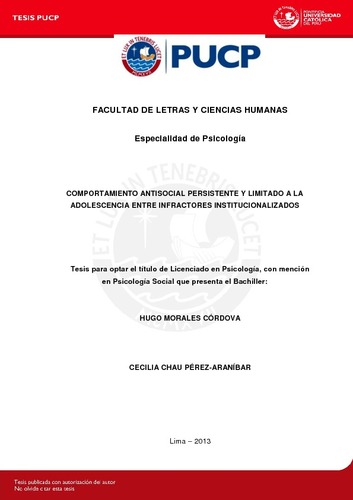| dc.contributor.advisor | Chau Pérez-Aranibar, Cecilia Beatriz | es_ES |
| dc.contributor.author | Morales Córdova, Hugo | es_ES |
| dc.date.accessioned | 2014-02-12T21:03:16Z | es_ES |
| dc.date.available | 2014-02-12T21:03:16Z | es_ES |
| dc.date.created | 2013 | es_ES |
| dc.date.issued | 2014-02-12 | es_ES |
| dc.identifier.uri | http://hdl.handle.net/20.500.12404/5102 | |
| dc.description.abstract | El presente estudio propone la versión adaptada por Iza (2002) en Lima del Millon
Adolescent Clinical Inventory – MACI, como una herramienta válida y confiable
para la evaluación del riesgo de reincidencia delictiva en una muestra de
adolescentes infractores peruanos, basándose en la teoría taxonómica del
desarrollo de la conducta antisocial propuesta por Terrie E. Moffitt (1993a, 2002).
De acuerdo con esta autora, la conducta antisocial adolescente puede ser
clasificada en dos tipos: una de curso precoz previo a la adolescencia (y
persistente en el curso de la vida), y otra de inicio tardío durante la adolescencia
(y limitada a la adolescencia). Utilizando el MACI como un instrumento de
valoración del riesgo de reincidencia a partir de la identificación de cada uno de
los grupos de conducta antisocial adolescente, será posible ofrecer tratamientos
diferenciados según las necesidades de riesgo criminogénico entre los
adolescentes infractores varones bajo tutela judicial en el Centro Juvenil de
Diagnóstico y Rehabilitación de Lima. La muestra está compuesta por 200
adolescentes entre 15 y 17 años con un promedio de edad de 17 años. Se
evidencia que quienes empezaron a una edad más temprana en la conducta
antisocial poseen los puntajes más altos en la prueba, mientras que quienes
debutaron en el delito siendo adolescentes, poseen los puntajes más bajos en las
escalas teóricamente asociadas a la conducta antisocial adolescente. Las escalas
que discriminan entre ambos grupos muestran diferencias estadísticamente
significativas. | es_ES |
| dc.description.abstract | This study aims to propose the Millon Adolescent Clinical Inventory - MACI
adapted by Iza (2002) in Lima as a valid and reliable tool for assessing the risk of
recidivism in a sample of adolescent offenders Peruvians, based on taxonomic
theory of development of antisocial behavior proposed by Terrie E. Moffitt (1993a,
2002). According to this author, adolescent antisocial behavior can be classified
into two types: one early course prior to adolescence (and persistent in lifetime),
and other late onset during adolescence (and limited to adolescence). Using the
MACI as a tool for assessing the risk of recidivism after identifying each of the
groups of adolescent antisocial behavior, it will be possible to provide
differentiated treatment to the needs of criminogenic risk among male juvenile
offenders under judicial measure at the Centre Youth Diagnostics and
Rehabilitation of Lima. We worked with a sample of 327 adolescents interviewed,
of which we obtained a final sample of 200 valid cases. The average age was 17
years. It showed that those who had started the antisocial behavior at a younger
age had the highest scores on the test, while those who had debuted in the crime
as teenagers, had the lowest scores on theoretically relevant scales associated
with antisocial behavior teenager. The relevant scales showed statistically
significant differences between both groups. | es_ES |
| dc.language.iso | spa | es_ES |
| dc.publisher | Pontificia Universidad Católica del Perú | es_ES |
| dc.rights | Atribución-NoComercial-SinDerivadas 2.5 Perú | * |
| dc.rights | info:eu-repo/semantics/openAccess | es_ES |
| dc.rights.uri | http://creativecommons.org/licenses/by-nc-nd/2.5/pe/ | * |
| dc.subject | Adolescencia. | es_ES |
| dc.subject | Delincuencia | es_ES |
| dc.subject | Psicología del adolescente | es_ES |
| dc.title | Comportamiento antisocial persistente y limitado a la adolescencia entre infractores institucionalizados | es_ES |
| dc.type | info:eu-repo/semantics/bachelorThesis | es_ES |
| thesis.degree.name | Licenciado en Psicología Social | es_ES |
| thesis.degree.level | Título Profesional | es_ES |
| thesis.degree.grantor | Pontificia Universidad Católica del Perú. Facultad de Letras y Ciencias Humanas | es_ES |
| thesis.degree.discipline | Psicología Social | es_ES |
| renati.discipline | 313066 | es_ES |
| renati.level | https://purl.org/pe-repo/renati/level#tituloProfesional | es_ES |
| renati.type | http://purl.org/pe-repo/renati/type#tesis | es_ES |
| dc.publisher.country | PE | es_ES |
| dc.subject.ocde | http://purl.org/pe-repo/ocde/ford#5.01.00 | es_ES |






